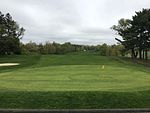Queens High School of Teaching
2003 establishments in New York CityEducational institutions established in 2003Glen Oaks, QueensPublic high schools in Queens, New York

The Queens High School of Teaching, Liberal Arts and the Sciences (QHST) (26Q566) is a public high school in Glen Oaks, New York, United States. It is located on the Frank A. Padavan Campus, a sprawling 32-acre (130,000 m2) landscaped campus, which contains QHST and two other neighboring kindergarten-8th grade schools: P.S./I.S. 266 and P.S./I.S. 208. It is one of the only schools in New York City that has a campus. The campus—originally named the Glen Oaks Campus—was renamed in 2008 in honor of a state senator who at the time was running for re-election.The school opened in the fall of 2003. It currently serves grades 9-12.
Excerpt from the Wikipedia article Queens High School of Teaching (License: CC BY-SA 3.0, Authors, Images).Queens High School of Teaching
Commonwealth Boulevard,
Geographical coordinates (GPS) Address Phone number Website Nearby Places Show on map
Geographical coordinates (GPS)
| Latitude | Longitude |
|---|---|
| N 40.7444 ° | E -73.7289 ° |
Address
Glen Oaks Campus
Commonwealth Boulevard 7430
11426 , Queens County
New York, United States
Open on Google Maps








